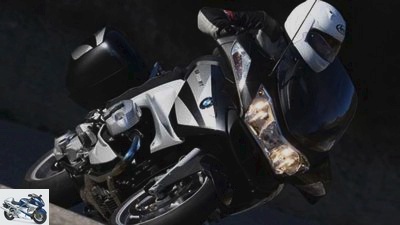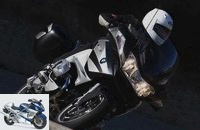Menus

Jahn
Driving report of the BMW Tourer
The BMW R 1200 RT in the test
What a few new stickers and a changed line make up: The touring boxer R 1200 RT looks significantly slimmer – and thanks to Dohc heads, should generate more steam.
It is a real classic, like the GS, a long-running hit that no competitor has so far been able to hold a candle to. The RT, the touring boxer, has been around for more than three decades, namely since 1978. Initially intended as a counterpart to the fully faired Harleys that were successful in the USA, the R 100 RT quickly established its market in Europe. In some countries, such as France, the RT even trumped the bestseller R 1200 GS. In Germany, however, the demand has lessened a little recently, with 814 units, the R 1200 RT only took 33rd place in the registration statistics last year.
So it’s time for an update. And that now comes in the form of some visual and technical innovations. Decorative elements on the plastic casing and on the suitcases testify to the aim of making the travel steamer appear less bulky. And this endeavor is definitely crowned with success, the new model looks sleeker, less bulky. While the entire rear area remained practically unchanged, the modellers were allowed to lend a hand in the front area. The plastic dress looks familiar at first glance, but has been completely redesigned. The designers used all imaginable tricks to make the RT appear lighter and more dynamic, for example interrupted surfaces, light edges and glued decors. All that remains is the wide headlight with its bright, double low beam.
Buy complete article

Driving report of the BMW Tourer
The BMW R 1200 RT in the test
Jahn
First Class: Unique ride comfort thanks to the velvety chassis and smooth boxer feeling.
For most RT buyers, the changes to the engine will be more important. They essentially consist of the new Dohc cylinder heads with radially arranged valves, which originally come from the HP2 sports boxer and are now also used in the GS. Just for the sake of clarity: there have of course been four valves in the boxer for a long time, but actuation via two camshafts above and small rocker arms, thanks to the reduced moving masses, gives more freedom in the control times and greater speed stability. In addition, the radial arrangement of the valves should result in a more favorable combustion chamber and thus more effective combustion.
In the case of the RT, however, the new heads do not enable more peak performance, but rather a slightly more powerful torque and a maximum speed increased by 500 rpm. The benchmarks: 110 hp as before, now at 7750 rpm (previously 7500 rpm), and 120 Nm instead of 115 Nm, still at 6000 rpm.
You already suspect: It’s not the big step – and it shouldn’t be. The renovated RT doesn’t feel much different from its predecessor for the first few meters. The gently pulsing boxer continues to massage the driver with his steady beat. But the power is now more spontaneous and more direct when the load changes, the engine appears livelier. Subjectively, the Dohc boxer appears more powerful in the lower area. The measured values in the first MOTORRAD test will show exactly what it brings.
The sound was also more robust thanks to the exhaust flap, which allows a slightly more open interior in the silencer, which has hardly changed from the outside. But the difference is much smaller than with the similarly modified GS. The driver hardly notices anything, the sound is now more present for outsiders. For the on-board personnel, the noise generated by the airstream is more important anyway. And that could be reduced by using a wider disc at the top. There is less turbulence and the wind protection is better, especially when the windshield is only slightly raised. In addition, according to BMW, the optical qualities of the lens have been improved. Less distortion should lead to the fact that the window is also likely to be raised to the highest position, i.e. the driver can see through it instead of over it.
The chassis can also be adjusted at the push of a button – if you have chosen the highly recommended ESA option. In the evolution stage ESA II, in addition to the rear and front damping, the spring preload and rate at the rear are also changed. This manifests itself in a wider setting range, the differences between the individual levels can be felt more clearly.
Nice features that BMW offers for an extra charge. Many of which are anything but plaything, but really useful extras. For example, in addition to the mandatory ESA II, the on-board computer, slip control, cruise control and all kinds of luggage and travel accessories. Configured in this way, however, you can easily pay 18,000 euros. Most will surely save another 1000 euros extra for the radio.
Overall, the renovated RT has remained the same, the many small measures of the update can only be noticed in a direct comparison. And that will follow in the next issue, when new and old RTs face the top test.
Jahn
Familiar arrangement of instruments and display, but new design and bezel rings as surrounds.
For the on-board personnel, the noise generated by the airstream is more important anyway. And that could be reduced by using a wider disc at the top. There is less turbulence, the wind protection is better, especially when the windshield is only slightly raised. In addition, according to BMW, the optical qualities of the lens have been improved. Less distortion should lead to the fact that the window is also likely to be raised to the highest position, so the driver can see through it instead of over it.
The chassis is also adjustable at the push of a button – if you have chosen the highly recommended ESA option. In the evolution stage ESA II, in addition to the rear and front damping, the rear spring preload and rate are also changed. This manifests itself in a wider setting range, the differences between the individual levels can be felt more clearly.
Nice features that BMW offers for an extra charge. Many of which are anything but plaything, but really useful extras. For example, in addition to the mandatory ESA II, the on-board computer, slip control, cruise control and all kinds of luggage and travel accessories. Configured in this way, however, you can easily pay 18,000 euros. Most will surely save another 1000 euros extra for the radio.
Overall, the renovated RT has remained the same, the many small measures of the update can only be noticed in a direct comparison. And that will follow in the next issue, when new and old RTs face the top test.
Technical data from BMW
Manufacturer
The BMW R 1200 RT.
Engine:
Air / oil-cooled two-cylinder four-stroke boxer engine, one balancer shaft, two overhead, chain-driven camshafts each, four valves per cylinder, bucket tappets, bumpers, rocker arms, wet sump lubrication, injection, Ø 47 mm, controlled catalytic converter, 720 W alternator, Battery 12 V / 19 Ah, hydraulically operated single-disc dry clutch, six-speed gearbox, cardan.
Bore x stroke 101.0 x 73.0 mm
Displacement 1170 cc
rated capacity 81.0 kW (110 hp) at 7750 rpm
Max. Torque 120 Nm at 6000 rpm
Landing gear:
Load-bearing engine-gear unit, telescopic fork, Ø 35 mm, two-jointed single-sided swing arm made of aluminum, central spring strut, directly hinged, adjustable spring base and rebound damping, double disc brake at the front, Ø 320 mm, four-piston fixed calipers, disc brake at the rear, Ø 265 mm, double-piston Floating caliper, partially integral brake system with ABS, cast aluminum wheels 3.50 x 17; 5.50 x 17
Tires 120/70 ZR 17; 180/55 ZR 17
Mass and weight:
Wheelbase 1485 mm, steering head angle 63.4 degrees, caster 110 mm, spring travel f / r 120/135 mm, seat height 820-840 mm, empty weight (without case) 259 kg, permissible total weight 495 kg, tank capacity / reserve 25.0 / 4.0 liters.
Guarantee two years
Colours Gray, white, Gau / silver
price from 16,200 euros
Additional costs around 269 euros
What’s new?
The changes at a glance:
- Newly styled fairing with improved wind protection and modified windshield
- Dohc cylinder heads for increased torque and a wider speed range, top output unchanged at 110 hp
- Instruments in a different design, now protected by screens
- Revised handlebar switches and fittings
- Exhaust flap for better sound
- Optional ESA-II undercarriage with improved effect and a wider adjustment range
- Shift lever adjustable within reach
- New audio system with simplified operation
Related articles
-
Driving report: Yamaha XT 1200 Z Super Tenere
Mayer 23 photos Yamaha 1/23 The wheel speed sensors for ABS and traction control receive their signals from radially mounted rings. Yamaha 2/23 In the…
-
Driving report: BMW R 1200 C The desert is shaking In the barren landscape of the US state of Arizona BMW presented the cruiser R 1200 C a few days ago….
-
BMW R 1200 RS in the driving report
fact 28 photos fact 1/28 BMW R 1200 RS. fact 2/28 BMW R 1200 RS. fact 3/28 BMW R 1200 RS. fact 4/28 BMW R 1200 RS. fact 5/28 BMW R 1200 RS. fact 6/28 BMW…
-
Honda X-ADV (2018) in the driving report
Honda 11 photos Honda 1/11 Honda sees the X-ADV as a Adventure bike at. Honda 2/11 How well does the 2018 model do in the first test? Honda 3/11 The…
-
Triumph Bonneville Bobber in the driving report
triumph 16 photos triumph 1/16 The first test drive with the new Triumph Bonneville Bobber. triumph 2/16 Unfortunately, the weather didn’t play along on…
-
KTM 1290 Super Adventure in the driving report
KTM 20th photos KTM 1/20 KTM 1290 Super Adventure. KTM 2/20 KTM 1290 Super Adventure. KTM 3/20 KTM 1290 Super Adventure. KTM 4/20 KTM 1290 Super…
-
BMW R nineT Scrambler in the driving report
BMW, jkuenstle.de 15th photos BMW, 1/15 After the successful R nineT comes the R nineT Scrambler. BMW, 2/15 With the BMW…
-
Aprilia RSV4 RF (2017) in the driving report
Photo: Aprilia 22nd photos 1/22 On the track, Aprilia’s RSV4 superbike weapon is a force to be reckoned with. The revised RF version goes one better with…
-
BMW F 900 XR in the driving report
BMW 8th photos BMW 1/8 The XR range has so far been made up of the S 1000 XR alone. Now the BMW F 900 XR joins them. BMW 2/8 It costs from 11,400 euros….
-
Driving report Triumph Tiger 800 XCx and XRx
triumph 31 photos triumph 1/31 triumph 2/31 triumph 3/31 triumph 4/31 triumph 5/31 triumph 6/31 triumph 7/31 triumph 8/31 triumph 9/31 triumph 10/31…